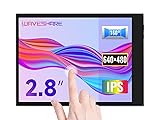All Categories
NEULOG Calcium Logger Sensor, 15 bit ADC Resolution
Share Tweet
*Price and Stocks may change without prior notice
*Packaging of actual item may differ from photo shown
- Electrical items MAY be 110 volts.
- 7 Day Return Policy
- All products are genuine and original








About NEULOG Calcium Logger Sensor, 15 Bit ADC Resolution
NeuLog logger sensor measures ionic calcium (Ca2+) concentration in aqueous samples, and can be used to evaluate water quality and determine calcium-magnesium levels by ethylenediaminetetraacetic acid (EDTA) titration for further study. The logger sensor has an ion-selective calcium electrode probe for calculating calcium levels, and a sealed, gel-filled reference chamber that requires no refill solution for ease of use. The logger sensor has an experiment duration of 1.0 second to 31.0 days, with 15 bit analog-to-digital converter (ADC) resolution for reading a range of values. In addition to the calcium electrode probe, the sensor operates with calcium ionic strength adjuster (ISA) and calcium 1,000.0ppm standard (included). Supplementary equipment required to conduct calcium sensor experiments include a wash bottle with distilled or deionized water, several clean beakers, and 1.0mL, 10.0mL, and 100.0mL pipettes (sold separately). The calcium logger sensor can be used for environmental, ecology, chemistry, and biology experiments, and is suitable for grade 3 and higher, or ages 10 to 21. The logger sensor consists of a data logger, flash memory, and a sensor for fully self-contained data gathering, and is plug-and-play for immediate readings as soon as it is connected. The logger sensor sends data in digital format to a PC, Mac, tablet, smart phone, or other viewer device, and provides multiple connection options, including USB and wireless. The logger sensor’s browser-based software adjusts ranges and gains, and provides applications for presenting data, including online and offline modes, tables, graphs, data analysis, double-axis set up, statistic operations, and mathematical operations. The logger sensor is encased in durable plastic, and has an LED indicator to track experiment status, with push buttons for calibration and start/stop experiments in offline mode for ease of operation. To take an assortment of readings during a single experiment, the logger sensor can be attached to another sensor; one to 10 logger sensors can be used per experiment (sensors sold individually). For efficiency, the logger sensor can store up to five experiments in flash memory, and saved experiments can be uploaded to a PC or Mac at any time. Additional accessories, such as USB, Wi-Fi, or battery modules, are required for operation depending on the device (PC, tablet, viewer, and so on) used to receive readings from the sensor. (Accessories and devices sold separately.) The logger sensor includes a guide with instructions for use and care, and measures 6.5 x 7.0 x 1.5cm (L x W x H). (L is length, the horizontal distance from left to right; W is width, the horizontal distance from front to back; H is height, the vertical distance from the lowest to highest point.) Logger sensors are electronic devices used to record a variety of energy and environmental measurements, such as temperature, humidity, voltage, and soil moisture, at set intervals over a period of time in scientific classroom and field settings. SpecificationsRange and operation modes 0.02 to 40,000 mg/L0.02 to 40,000 mg/LADC resolution 15 bitResolution 0.03 mg/L (0.02 to 100 mg/L) 0.1 mg/L (100 to 1,000 mg/L) 130 mg/L (1,000 to 40,000 mg/L) 0.03 ppm (0.02 to 100 ppm) 0.1 ppm (100 to 1,000 ppm) 130 ppm (1,000 to 40,000 ppm) Maximum sample rate (S/sec) 100.0 Science education products incorporate applied math and science principles into classroom and homeschool-based projects. Teachers in pre-K, elementary, and secondary classrooms use science education kits and products alongside science, technology, engineering, and math (STEM) curriculum to demonstrate STEM concepts and real-world applications through hands-on activities. Science education projects include a broad range of activities, such as practical experiments in engineering, aeronautics, robotics, energy, chemistry, physics, biology, and geology. NeuLog brand products, manufactured by EISCO Scientific and Science Educational Systems (SES), include logger sensors, software, and accessories for energy and environmental data acquisition and measurement. EISCO Scientific was founded in 1968, and is headquartered in Rochester, NY; SES was founded in 1983, and is headquartered in Israel. Both companies meet International Organization of Standardization (ISO) standard 9001. What’s in the Box? Calcium logger sensorCalcium sensor electrodeCalcium ionic strength adjuster (ISA)Calcium 1,000.0ppmGuide



























